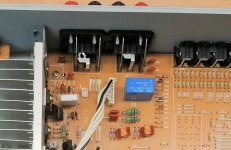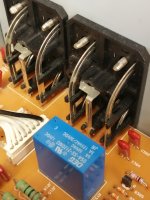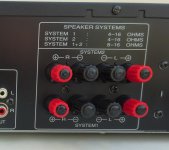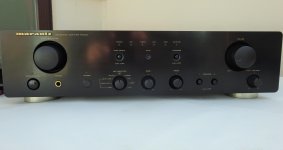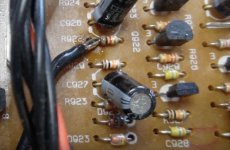After a period of between a few seconds, and a few minutes (sometimes longer) the MUTE light would come on after a click (speaker circuit disengaging), and the sound would go dead.
Please see attached pictures.
I presume this is some sort of protection circuit trying to prevent damage to the amplifier. What I found was that each speaker post had its own connection to the pcb, but each group of 4 connections had a central connection that connected to earth (I presume to use as a reference for the protection circuit). I noticed that on one bank of four this central earth connection wasn't seated correctly, and after reshaping it, pushing it in and screwing it up, it seems to now be working okay. It's been running for over 3 hours now without a hiccup.
The two screws that hold the 8 speaker connectors in place on the back panel, are what screw into the earth connection and earth it to the back panel.
Hopefully this info could help others.
I have no idea how it got like that, and think it must have been like that when I bought it (second hand).
Rob
Please see attached pictures.
I presume this is some sort of protection circuit trying to prevent damage to the amplifier. What I found was that each speaker post had its own connection to the pcb, but each group of 4 connections had a central connection that connected to earth (I presume to use as a reference for the protection circuit). I noticed that on one bank of four this central earth connection wasn't seated correctly, and after reshaping it, pushing it in and screwing it up, it seems to now be working okay. It's been running for over 3 hours now without a hiccup.
The two screws that hold the 8 speaker connectors in place on the back panel, are what screw into the earth connection and earth it to the back panel.
Hopefully this info could help others.
I have no idea how it got like that, and think it must have been like that when I bought it (second hand).
Rob
Attachments
Consult the service manual for voltage readings in fault mode and when working. Pay attention to the DC voltage on the output stage to the speaker. It should be zero volts with no signal input and no speaker connected.
If there is more than 200mV either + or -ve to the 0v point, it will enter protect mode.
Your issue could be a temporary poor connection on the speaker poles, causing over current to trigger the protection mode.
If there is more than 200mV either + or -ve to the 0v point, it will enter protect mode.
Your issue could be a temporary poor connection on the speaker poles, causing over current to trigger the protection mode.
Last edited:
Hi this issue is well documented and is caused by poor grounding.
See this video and technical description to fix the issue.
Marantz PM4000 Amplifier Repair - YouTube
See this video and technical description to fix the issue.
Marantz PM4000 Amplifier Repair - YouTube
Hi Audio Service,
I didn't really understand what that YouTube video was trying to show? Looks like there was an extra wire added to a resistor, and maybe something to do with the relay - all a bit confusing (just music playing).
If I measure the dc voltage at the speaker connections (no speakers attached) with no input, do I have to ground the signals at the RCA input connection I've selected as the input, or can I just leave them with nothing connected to get a good reading. What measurement is this known as, DC Offset?
Thanks, Rob
I didn't really understand what that YouTube video was trying to show? Looks like there was an extra wire added to a resistor, and maybe something to do with the relay - all a bit confusing (just music playing).
If I measure the dc voltage at the speaker connections (no speakers attached) with no input, do I have to ground the signals at the RCA input connection I've selected as the input, or can I just leave them with nothing connected to get a good reading. What measurement is this known as, DC Offset?
Thanks, Rob
Last edited:
Measuring at the speaker terminals with no speakers attached and nothing on the selected input gives me about 12mV on each side. By measuring at CN37 and CN38, and adjusting VR31 and VR32 (correspondingly) I've adjusted this down to zero, is this the correct thing to do?
The amp has been on for over 12 hours with not a glitch (before I did this adjustment), so I wonder if reseating the earth connection that the screw at the speaker terminals has cured it - See original pictures.
The amp has been on for over 12 hours with not a glitch (before I did this adjustment), so I wonder if reseating the earth connection that the screw at the speaker terminals has cured it - See original pictures.
There is an issue with poorgrounding so re seating the connections on the rear has probably fixed it for you.
Zero volts across the speaker terminals with no signal and no speakers connected is ideal Anything less than 50mV is good.
Zero volts across the speaker terminals with no signal and no speakers connected is ideal Anything less than 50mV is good.
Thanks.
I will continue testing it over the next couple of days, to be certain what I've done has resolved the issue. If it hasn't I'll have a go at adding that link.
Many Thanks, Rob
I will continue testing it over the next couple of days, to be certain what I've done has resolved the issue. If it hasn't I'll have a go at adding that link.
Many Thanks, Rob
I would also advise
Due to the age of this Amplifier the speaker protection relay should be replaced and all dry joints on the main Amplifier board and input power board should be re-flowed.
Particular attention should be paid to the input RCA connectors, and the voltage regulators for the plus and minus 15 volt supply and the 5 volt regulator for the Micro.
Often dry joints will also be seen on the driver transistors in the output stages.
Due to the age of this Amplifier the speaker protection relay should be replaced and all dry joints on the main Amplifier board and input power board should be re-flowed.
Particular attention should be paid to the input RCA connectors, and the voltage regulators for the plus and minus 15 volt supply and the 5 volt regulator for the Micro.
Often dry joints will also be seen on the driver transistors in the output stages.
Many thanks for the info.
I'll get the link fitted, then look into the other stuff and see if I can get a new relay too.
Rob
I'll get the link fitted, then look into the other stuff and see if I can get a new relay too.
Rob
Since my first original post were I reseated the earthed terminal (that the speaker connector screw goes into) the amplifier hasn't missed a beat, even when leaving on overnight.
However I've done the earth wire mod suggested, replaced the speaker relay, and re soldered the suggested areas, and all is still well. I'm now confident this is a well repaired amplifier.
Thanks to all, Rob
However I've done the earth wire mod suggested, replaced the speaker relay, and re soldered the suggested areas, and all is still well. I'm now confident this is a well repaired amplifier.
Thanks to all, Rob
- Home
- Amplifiers
- Solid State
- Marantz PM4000 Amplifier Muting after short period
